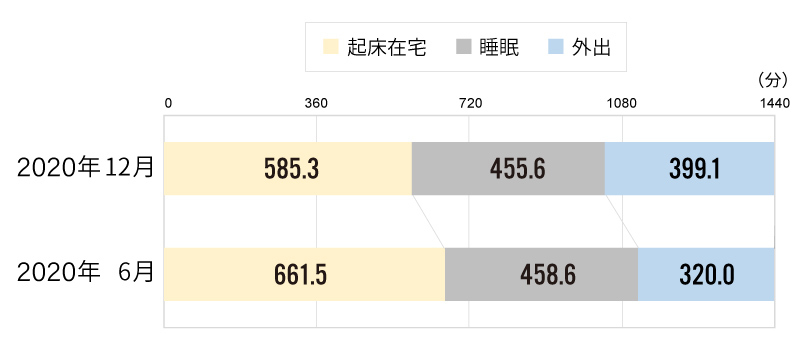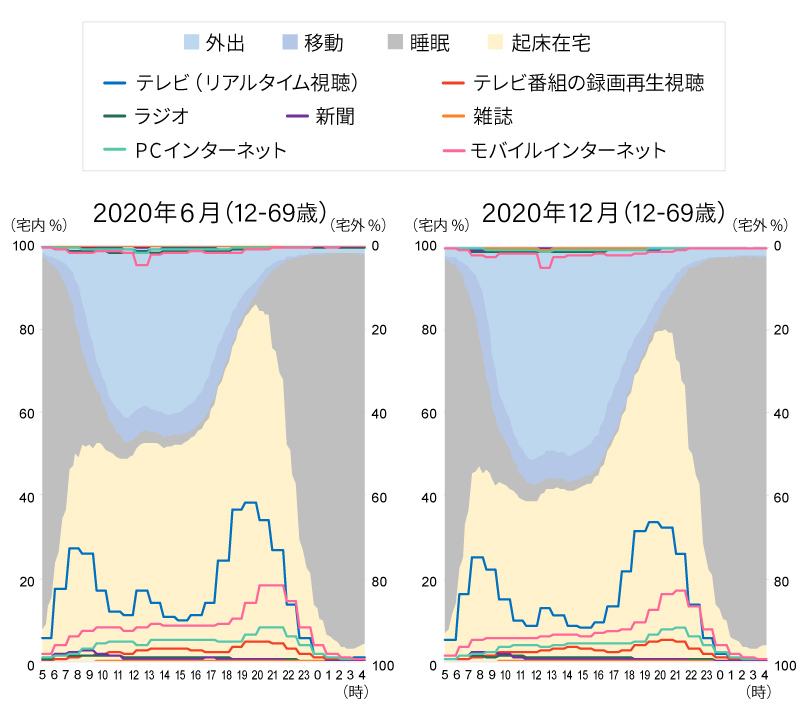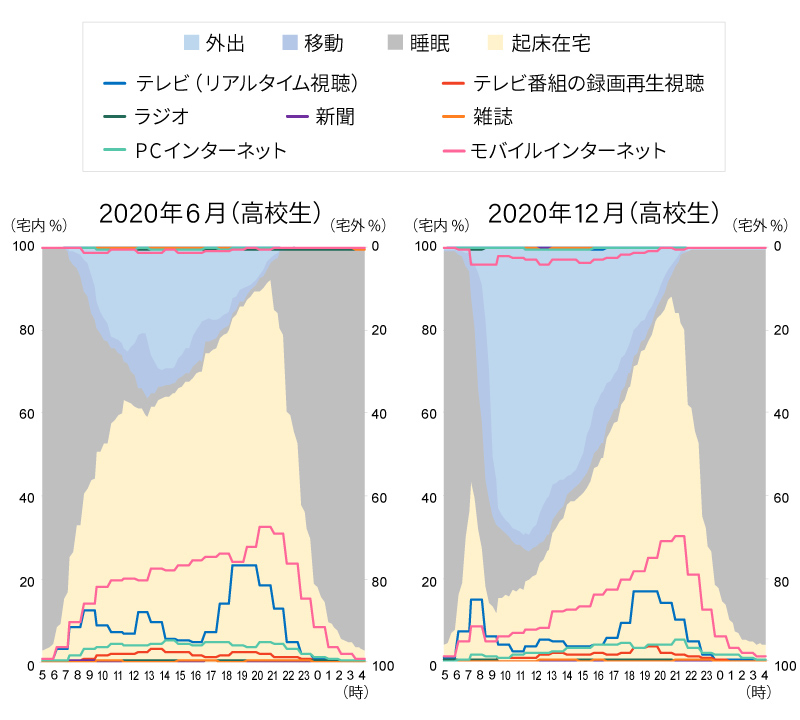This series introduces parts of the opening feature from Dentsu Inc. Media Innovation Lab's " Information Media White Paper 2021 " (published by Diamond Inc.). Last time, based on MCR/ex survey data for the first half of 2020 within Tokyo's 50km radius (*1), we reported on the strong demand for online media under COVID-19's impact in June 2020 and how radio and newspapers were "rediscovered."
How did lifestyles and media usage change thereafter? This final installment of the series examines the situation six months later. The second-half 2020 survey was conducted from December 7 to 13, 2020, as the third wave of COVID-19 infections was beginning. Please read this alongside the first article in this series.
While seasonal differences must naturally be considered when comparing June and December behavioral data, this article focuses on comparing the two points in 2020, given the profound impact the pandemic had on overall lifestyle behaviors.
*1 = MCR/ex Survey
A diary-style survey conducted by Video Research Ltd. over a specific week. It captures consumers' activities—including basic daily routines and media exposure—by day of the week along a time axis, in minimum 15-minute increments.
Lifestyle patterns have partially returned to pre-pandemic levels, though not yet reaching 2019 levels
June 2020 data showed many people refraining from going out, creating a situation that could be described as "nesting." To confirm basic daily activities six months later, Figure 1 shows the average daily (weekly average) time spent awake at home, sleeping, and going out for the entire individual population (ages 12-69) in June and December 2020.
In December 2020, time spent going out increased by 79.1 minutes compared to six months earlier, while time spent at home after waking decreased by 76.2 minutes to 585.3 minutes. This suggests the extreme "nesting" tendency had eased. However, since time spent at home after waking in June 2019 (pre-COVID) was 519.8 minutes, daily patterns had not returned to pre-pandemic levels.
Meanwhile, sleep time has only decreased by 3.0 minutes from June 2020 (458.6 minutes), which saw a significant increase from 2019 (441.0 minutes).
[Figure 1] Daily Time Spent Awake at Home, Sleeping, and Outdoors (Weekly Average / Ages 12-69)

Source: Created based on Video Research Ltd. MCR/ex Tokyo 50km Circle (June and December 2020)
A Rebound Trend in Media Usage Time at Home
In tandem with time spent at home after waking, time spent using various media at home also shows signs of partially returning to previous levels. Figure 2 shows the average daily media contact time at home (weekly average) for all individuals in June and December 2020. The total contact time across all media (including overlapping contact) decreased from 370.0 minutes to 325.2 minutes. However, since the pre-pandemic level in June 2019 was 295.3 minutes, it can be said that media contact at home is occurring at a higher level than before the pandemic.
While showing a decrease compared to June 2020, there is momentum in internet usage, particularly via mobile devices, when compared to the June 2019 usage levels. Furthermore, while time spent listening to radio and watching online videos on TV sets (TV videos) – activities confirmed to have increased during the pandemic – has decreased slightly compared to six months prior, it still exceeds the June 2019 level. This indicates a gradual increase despite some rebound.
On the other hand, recorded playback is a medium whose contact time has increased since June 2020. This can likely be attributed to the changes in daily activity time observed in Figure 1. It is presumed to reflect the situation where increased opportunities to go out made it difficult to watch TV programs in real time.
[Figure 2] Daily Media Contact Time at Home (Weekly Average / Ages 12-69)

Source: Created based on Video Research Ltd. MCR/ex Tokyo 50km Circle (June and December 2020)
Mobile Internet Usage Remains High
Let's also examine media usage patterns throughout the day. Figure 3 shows the trends in activity rates (awake at home, sleeping, commuting, going out) and media contact rates (in 60-minute intervals) for the entire population over a 24-hour period starting at 5:00 AM (weekly average).
While Figure 1 showed fluctuations in lifestyle patterns by time volume, changes can also be observed from activity rates throughout the day. By December 2020, the daytime dip in the "awake at home" rate (shown in yellow) became more pronounced, while the area of the "out and about" rate (shown in light blue) expanded compared to June. More people are now active outside their homes during the day, suggesting a slight easing of the "stay-at-home" trend. At home, television (live viewing) and mobile internet remain the most frequently used media, though both show a slight decrease in peak evening contact rates compared to June.
What about media usage outside the home? The contact rate for mobile internet outside the home in June and December 2020 increased from 1.6% to 2.3% during the morning commute hours around 8:00 AM, and from 4.3% to 4.8% during the peak contact hours around 12:00 PM. As opportunities to go out increased, corresponding changes in mobile internet usage were observed.
[Figure 3] Daily Activity Rates and Media Contact Rates (Weekly Average / Ages 12-69)

Source: Created based on Video Research Ltd. MCR/ex Tokyo 50km Circle (June and December 2020).
High School Students with Mobile Internet at the Center of Their Lives
The first article introduced how high school students' daily patterns changed significantly due to measures like remote classes, resulting in extremely high mobile internet usage throughout the day. Six months have passed since then. How have high school students' lives changed?
Figure 4 shows the daily (weekly average) activities of high school students in June and December 2020. Over this half-year period, their lifestyle patterns changed significantly. First, opportunities to go out increased. Furthermore, they actively use mobile internet while out.
Changes are also seen in media contact rates within the home. During the morning hours, contact with television (live viewing) (blue line) is notably high. However, during the daytime and evening, contact with mobile internet (pink line) exceeds that of television. Comparing June and December, the peak mobile internet contact rate decreased from 32.6% (9 PM hour) to 29.9% (10 PM hour). The peak TV contact rate also decreased from 23.4% (7 PM) to 16.9% (8 PM). The decline for TV was slightly larger. Therefore, the December 2020 data indicates that mobile internet is an extremely familiar medium for high school students both inside and outside the home.
[Figure 4] Daily Activity Rates and Media Exposure Rates (Weekly Average / High School Students)

Source: Created based on Video Research Ltd. MCR/ex Tokyo 50km Circle (June and December 2020)
The COVID-19 pandemic has significantly impacted our lives, and predicting the extent of its influence and when it will subside is difficult. Previous surveys also suggest its impact on the demand for information and entertainment. As we continue to explore a "new normal," it seems necessary to keep a close eye on how people engage with media going forward.
[Survey Overview]
Survey Name: MCR/ex
Conducted: Annually in June and December
Survey Method: Online questionnaire
Survey Areas: Tokyo 50km radius, Kansai region, Nagoya region, Northern Kyushu region, Sapporo region, Sendai region, Hiroshima region
Survey Participants: Individuals aged 12 to 69 (area-random sampling)
Survey Company: Video Research Ltd.








